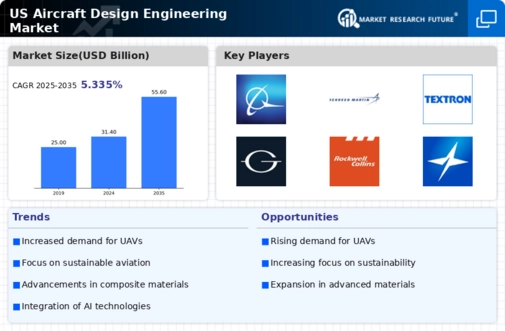The US Aircraft Design Engineering Market is characterized by a dynamic competitive landscape, where various firms strive to capture market share and establish themselves as leaders in innovation and technological advancement. The market is influenced by factors such as regulatory requirements, advancements in aerospace technology, and shifting consumer demands for more efficient and environmentally friendly aircraft solutions. Players within this market are continuously investing in research and development to enhance their design capabilities and meet the evolving standards of safety and performance.
With a growing focus on sustainability, companies are leveraging cutting-edge technologies such as artificial intelligence and advanced materials to optimize the design process, thereby achieving higher levels of efficiency and performance. The competitive insights within this sector reflect a battle for dominance, where legacy manufacturers compete against new entrants and niche players, often collaborating with government agencies and defense contractors to secure contracts and maintain relevance within the ever-evolving aerospace ecosystem.Raytheon Technologies has established a formidable presence in the US Aircraft Design Engineering Market, driven by its extensive expertise and innovation in aeronautics and aircraft systems.
The company’s strength lies in its robust research and development initiatives, which consistently yield cutting-edge technologies that enhance aircraft performance and safety. With a focus on integrating advanced avionics, propulsion systems, and digital engineering capabilities, Raytheon Technologies effectively positions itself as a leader in the field. Its strong partnerships with governmental and commercial aerospace sectors provide a solid foundation for growth, allowing the company to secure significant contracts that reinforce its market standing.
Additionally, Raytheon Technologies benefits from its comprehensive understanding of both military and civilian aircraft design, enhancing its ability to serve a diverse array of clients and projects.Boeing is a major player in the US Aircraft Design Engineering Market, known for its extensive range of products and services including commercial jetliners, military aircraft, and space systems. The company's market presence is bolstered by its legacy of innovation and its status as one of the largest aerospace manufacturers globally.
Boeing's strengths in research and development allow it to introduce advanced aircraft models that prioritize fuel efficiency and passenger comfort, while maintaining top-tier safety standards. The company has engaged in strategic mergers and acquisitions that have expanded its capabilities and product offerings, such as integrating advanced technology firms into its operational framework. This enables Boeing to remain competitive by harnessing new technologies and enhancing its engineering processes. The strategic focus on sustainability and reduced environmental impact positions Boeing well within the market, aligning with the broader industry shifts toward greener aviation solutions.
Overall, Boeing's extensive experience, comprehensive service offerings, and innovative approaches solidify its leadership status in the US Aircraft Design Engineering Market.


















